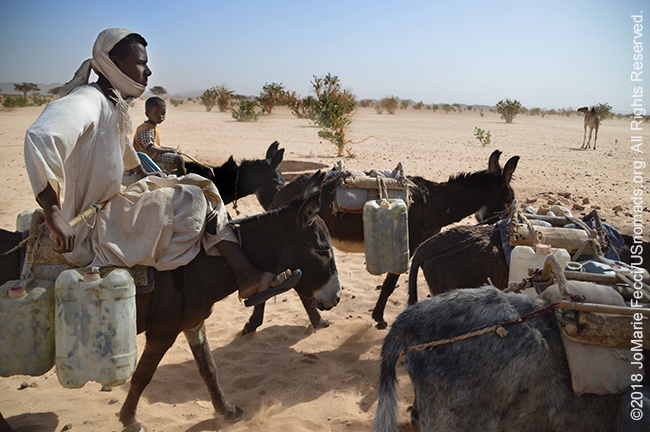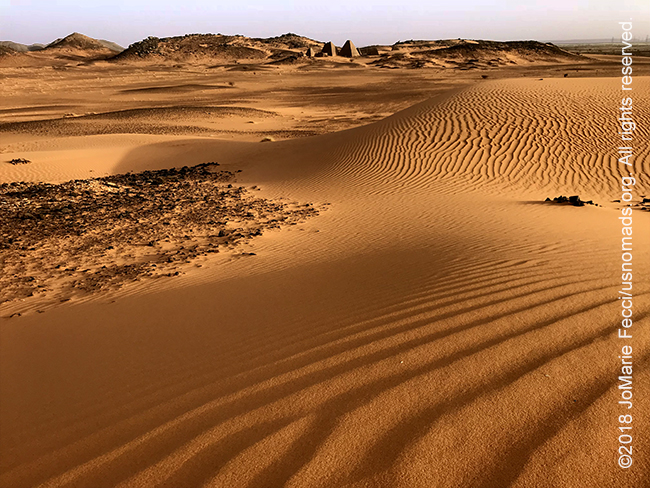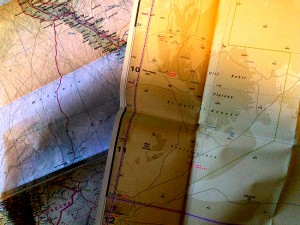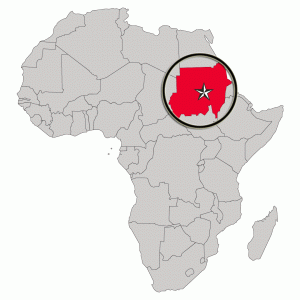
MEROE, SUDAN (11 April 2018) — The sun came up over the silence of the desert where we were tucked in behind a hill of rocks and it was time to break camp before we ran out of shade. A nomadic family was grazing their goats under the acacia tree where I had been photographing yesterday afternoon, and the father had climbed high up into its branches and was gently shaking them with his staff to provide fodder for his herd. The children ran after some stray goats and tentatively came over to our camp, curious as to what brought us into their pasture land.
We shared what was left of our camp food supply with them, and then packed up and continued our route to the east. We stopped for a break at a well not very far from where we would intercept the tar road. Maybe it was the time of day or closeness to the more populated areas, but there was quite a crowd drawing water, filling plastic jugs, or watering their livestock. Donkeys and camels waited patiently while their owners accessed the communal well.
One thing I noticed was that it was mostly men getting the water. Somehow I was surprised by that fact, as in other places I recall seeing mostly women and girls, or at least more of an equal mix of genders at the wells. Perhaps it was just coincidence, or that this was the time of day when the men herding camels went for water.
When I mentioned the observation Gammal and Sami explained that in the desert most nomad women were “shy.” I thought that at first this comment was a cultural stereotype, but they explained further, citing as an example that nomad girls and women would run away if they saw a car coming and they were alone. I was not convinced until later on when this actually happened to us, even though I was driving the vehicle — a teen-aged girl who was getting water for her goats literally dropped her bucket, spilling the precious water on the sand and ran off leaving the goats and the plastic water jug behind. It was a strange occurrence but did support the earlier point. And she probably did not take the time to see that a western woman was driving.
We were almost to the tar road when the dust blew up without warning. A grey veil of fine sand made it near impossible to see, and we drove slowly on a straight heading towards where we knew the road to be. The presence of a tar road as an eventual “landmark” helped make the navigation more “sure” and we did not need to use the GPS for backup — we knew that when we reached that road, we would take it to the south. We probably were not driving for that long in these “instrument conditions” but it seemed like forever, and it was a great relief to finally cross on to the blacktop — though we still could not see a thing.
Eventually the sand stopped blowing as suddenly as it started and we soon reached the bustling town of Atbara. The gas line was long, but we wanted to maintain our reserve gas for an emergency so we got in the queue and inched our way to the pumps. While we were stopped there we also replenished our supplies. Though tonite would be our last evening camping in the desert, we had given our extra food to the nomads, so now needed to get some more for ourselves. Compared to the solitude of the Bayuda, the town of Atbara seemed chaotic and speedy, though it was really neither. It was just a crossroads, and the beginning of our return towards the urban center of Khartoum.
When we left the town center we were on the highway. It is a major corridor for goods being transported from the Port to the capital and beyond. Big heavily laden trucks sped along the route. As we made our way south we passed a well-dressed man with a relatively new car on the side of the road. His hood was up and he had a young child with him. Gammal, Sami and I looked at each other and silently agreed we had to go back to try to help them. I was surprised that none of the truckers had stopped, but Sami explained that they were all in a hurry to get their goods to the destination and would not take time to stop. We looped back around and pulled up next to the family. The man’s wife sat quietly in the car looking very worried.
The vehicle had an electrical failure. Their battery was dead. Luckily this was something we could help with, so we quickly jump started their car. When it was running again, the family was so thankful. The young daughter was all smiles and the man asked to take a selfie with us! I was very glad we had stopped and were able to actually help them get back on their way.
We then continued south the rest of the way to Meroe, the most “touristic” of our destinations thus far. Meroe was the center of the ancient royal kingdom at it’s height of glory. The pyramids there are perhaps the most famous in all Sudan. They are most notable visually because their tops were systematically blown off by a European adventurer who was searching for gold in the 1800s.
As we reached the site of the pyramids from the main road we came across the requisite souvenir sellers and camel guys — the first ones we had actually encountered during the whole journey in Sudan. There were just a few of them and they were not at all aggressive like those who work around the Great Pyramids of Egypt. At Meroe there was a civilized politeness that made it all a much nicer experience. I did buy a small souvenir from some young girls who were selling sandstone carvings they made themselves and I even made plans with one of the camel guys to take a camel to explore the pyramid fields in the morning. Then I set off on foot while Gammal and Sami took the truck around to the archeologist’s camp on the other side of the necropolis. I would join them there later, but wanted to just wander among the pyramids in solitude for my last sunset out in the Sudanese desert. I hadn’t realized the distance from the pyramids to the camp, which didn’t seem so far visually, but turned out to be quite a hike. Nevermind, the sun was getting low in the sky and the sand was turning that golden color, and the topless pyramids, too, were glowing gold. A slight breeze was blowing sand every so lightly and I was surrounded by the magic of the Sahara …

ABOUT THE EXPEDITION

JoMarie Fecci, of USnomads, sets off on an independent scouting trip across Egypt and Sudan in preparation for an up-coming Sahara expedition. Driving locally-sourced Toyotas and working with small local teams in each region, she will traverse a winding route that jumps off from key points along the Nile as far south as Khartoum, where the Blue and White Niles meet. During the journey she will visit a series of UNESCO world heritage sites focused on the ancient civilizations that occupied the region and meet with local communities. The primary goal of this mission is to assess terrain, security, driving conditions, logistical concerns and approximate timeframes for future travel.
WHERE WE ARE

The Sudan in Northeast Africa is bordered by Egypt to the north, the Red Sea, Eritrea and Ethiopia to the east, South Sudan to the south, the Central African Republic to the southwest, Chad to the west and Libya to the northwest. The country has a total area of 1.861.484 square kilometres (718.722 square miles), making it the third largest in Africa. The terrain is generally flat plains, broken by several mountain ranges. In the west the Deriba Caldera (3,042 m or 9,980 ft), located in the Marrah Mountains, is the highest point in Sudan. In the east are the Red Sea Hills. The name Sudan derives from the Arabic “bilād as-sūdān” or “the lands of the Blacks.” The population of roughly 37 million people is made up of 597 different ethnic or tribal groups speaking over 400 different languages and dialects. Sudanese Arabs are by far the largest ethnic group, estimated to account for 70% of the population. They are almost entirely Muslims. The majority speak Sudanese Arabic, with some different Arabic dialects, while many Arabized and indigenous tribes like the Fur, Zaghawa, Borgo, Masalit and some Baggara ethnic groups, speak Chadian Arabic. The nation’s official languages are Arabic and English. Sudanese history goes back to Antiquity, when the Meroitic-speaking Kingdom of Kush controlled northern and central Sudan and, for nearly a century, Egypt.